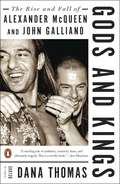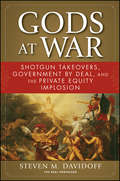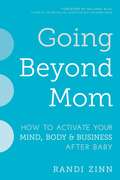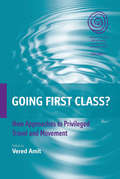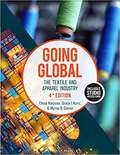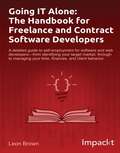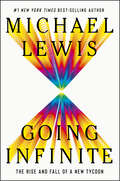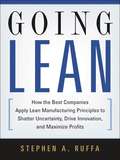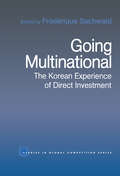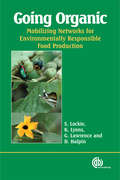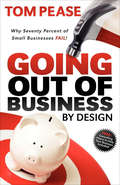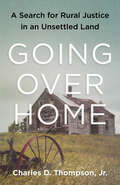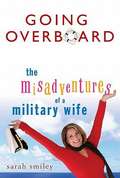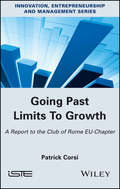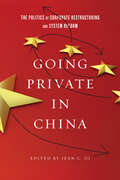- Table View
- List View
Godrej Agrovet Ltd (GAVL)
by Anjali Raina Jose B. Alvarez Rachna ChawlaNadir Godrej Chairman and B Yadav MD, Godrej Agrovet Ltd ( GAVL) grapple with the challenge of growing their cattle feed business - should they integrate vertically despite the challenges ofthe dairy industry, and risk the profitability of the current business ? The ban on cow slaughter in India adds to the dilemma.
Gods and Kings: The Rise and Fall of Alexander McQueen and John Galliano
by Dana ThomasMore than two decades ago, John Galliano and Alexander McQueen arrived on the fashions scene when the business was in an artistic and economic rut. Both wanted to revolutionize fashion in a way no one had in decades. They shook the establishment out of its bourgeois, minimalist stupor with daring, sexy designs. They turned out landmark collections in mesmerizing, theatrical shows that retailers and critics still gush about and designers continue to reference.<P><P> Their approach to fashion was wildly different—Galliano began as an illustrator, McQueen as a Savile Row tailor. Galliano led the way with his sensual bias-cut gowns and his voluptuous hourglass tailoring, which he presented in romantic storybook-like settings. McQueen, though nearly ten years younger than Galliano, was a brilliant technician and a visionary artist who brought a new reality to fashion, as well as an otherworldly beauty. For his first official collection at the tender age of twenty-three, McQueen did what few in fashion ever achieve: he invented a new silhouette, the Bumster.<P> They had similar backgrounds: sensitive, shy gay men raised in tough London neighborhoods, their love of fashion nurtured by their doting mothers. Both struggled to get their businesses off the ground, despite early critical success. But by 1997, each had landed a job as creative director for couture houses owned by French tycoon Bernard Arnault, chairman of LVMH.<P> Galliano’s and McQueen’s work for Dior and Givenchy and beyond not only influenced fashion; their distinct styles were also reflected across the media landscape. With their help, luxury fashion evolved from a clutch of small, family-owned businesses into a $280 billion-a-year global corporate industry. Executives pushed the designers to meet increasingly rapid deadlines. For both Galliano and McQueen, the pace was unsustainable. In 2010, McQueen took his own life three weeks before his womens' wear show.<P> The same week that Galliano was fired, Forbes named Arnault the fourth richest man in the world. Two months later, Kate Middleton wore a McQueen wedding gown, instantly making the house the world’s most famous fashion brand, and the Metropolitan Museum of Art opened a wildly successful McQueen retrospective, cosponsored by the corporate owners of the McQueen brand. The corporations had won and the artists had lost.<P> In her groundbreaking work Gods and Kings, acclaimed journalist Dana Thomas tells the true story of McQueen and Galliano. In so doing, she reveals the revolution in high fashion in the last two decades—and the price it demanded of the very ones who saved it.
Gods at War
by Steven M. DavidoffAn engaging exploration of modern-day deals and deal-makingGods at War details the recent deals and events that have forever changed the world of billion-dollar deal-making. This book is a whirlwind tour of the players determining the destiny of corporate America, including the government, private equity, strategic buyers, hedge funds, and sovereign wealth funds.It not only examines many of the game-changing takeover events that have occurred in the past years, but also puts them into context and exposes what is really going on behind the scenes on Wall Street. Gods at War completely covers the strategic issues that guide the modern-day deal, and since they unfold under the shadow of the law, it also focuses on the legal aspects of deal-making and takeovers.Each chapter unfolds through the lens of a recent transaction, from the battle between Yahoo! and Microsoft to the United Rental/Cerberus disputeProvides in-depth explanations and analysis of the events and actors that have shaped this fast-moving fieldExamines the federal government's regulation by deal approach to saving the financial system and explains the government's biggest "deals", including its bail-outs of AIG, Bank of America, and CitigroupFilled with in-depth insights that will enhance your understanding of this field, Gods at War offers an engaging look at deals and deal-makers in the context of recent historical events. It's a book for those who want to understand deals, takeovers, and the people and institutions who shape our world.
Gods in the Bazaar: The Economies of Indian Calendar Art
by Kajri JainGods in the Bazaar is a fascinating account of the printed images known in India as "calendar art" or "bazaar art," the color-saturated, mass-produced pictures often used on calendars and in advertisements, featuring deities and other religious themes as well as nationalist leaders, alluring women, movie stars, chubby babies, and landscapes. Calendar art appears in all manner of contexts in India: in chic elite living rooms, middle-class kitchens, urban slums, village huts; hung on walls, stuck on scooters and computers, propped up on machines, affixed to dashboards, tucked into wallets and lockets. In this beautifully illustrated book, Kajri Jain examines the power that calendar art wields in Indian mass culture, arguing that its meanings derive as much from the production and circulation of the images as from their visual features. Jain draws on interviews with artists, printers, publishers, and consumers as well as analyses of the prints themselves to trace the economies--of art, commerce, religion, and desire--within which calendar images and ideas about them are formulated. For Jain, an analysis of the bazaar, or vernacular commercial arena, is crucial to understanding not only the calendar art that circulates within the bazaar but also India's postcolonial modernity and the ways that its mass culture has developed in close connection with a religiously inflected nationalism. The bazaar is characterized by the coexistence of seemingly incompatible elements: bourgeois-liberal and neoliberal modernism on the one hand, and vernacular discourses and practices on the other. Jain argues that from the colonial era to the present, capitalist expansion has depended on the maintenance of these multiple coexisting realms: the sacred, the commercial, and the artistic; the official and the vernacular.
Gogoro: From Electric Scooter to Energy Platform
by Tarun Khanna Billy ChanThe founder of Gogoro had always wanted to revolutionize the energy market from day one since he started the electric scooter business that featured an innovative battery swapping technology. Over the course of five years, he had developed a premium line of electric scooters, gained market share to about 90 percent, and turned his startup into a "unicorn" with a valuation reaching $1 billion. With its battery swapping infrastructure built out across the island of Taiwan, Gogoro sensed the opportunity to become something bigger - most probably a smart energy platform that could complement the main grid. But as a sudden change in government subsidies and the outbreak of the coronavirus pandemic took a toll on the scooter sales, how should Gogoro position itself going forward?
Going Alt-Ac: A Guide to Alternative Academic Careers
by Kevin Kelly Thomas J. Tobin Kathryn E. LinderA growing number of people completing or holding graduate degrees now seek non-faculty positions—also called alternative academic, or “alt-ac” positions—at different stages in their careers. While an increasing number of people with doctoral degrees are hunting for a diminishing pool of tenure-track faculty jobs, most degree-granting institutions do not adequately prepare their graduate students to enter the new reality of the alt-ac job market. Yet the administrative ranks in higher education institutions are growing, as colleges and universities are creating a diverse range of positions that support teaching and learning efforts.Focusing on the range of potential alternative career choices, this highly practical book offers tools and prompts for readers who are:·Considering whether to choose an alt-ac career path·Seeking specific alt-ac positions·Advising graduate students or mentoring recent professional graduates·Encountering alt-ac career challengesThe authors offer case stories—their own and those of colleagues across North America in alt-ac roles—with concrete examples designed to help readers pursue, obtain, and excel in a wide variety of alt-ac positions. The book can equally be used as a resource for graduate courses on professional development and job-market preparation.
Going Beyond Mom: How to Activate Your Mind, Body & Business After Baby
by Randi ZinnBorn out of her popular website Beyond Mom, Randi’s book is a guide for mothers looking to jump-start their business ideas by finding connection from within. The 1.2 million women in America each year who choose not to return to traditional work after having children have found themselves filled with an unexpected creative energy, but lack the knowledge and network to tap it.With the support of the Beyond Mom community behind you, Randi provides the guidance and the tools women need to find their strength, body, and mind, thus laying the integral foundation to bring entrepreneurial ideas to fruition. Her distinct approach is as practically accessible as it is holistic—a former yoga teacher who also possesses a decade of experience as an acting CEO, she knows that personal well-being is critically connected to any thriving business venture. Because the first step to personal wellness and idea growth begins with you. In addition, each chapter features an interview from the Beyond Mom network of celebrity moms, successful businesswomen, and clients, like bestselling author and coach Alexandra Jamieson, renowned psychotherapist Terri Cole, IntenSati founder Patricia Moreno, and author/anthropologist Wednesday Martin, just to name a few. Honest, smart, and relatable, Randi provides wisdom and encouragement to build entrepreneurs (who are also moms) from deep within!
Going Circular: The Evolution of Reverse Logistics into a Competitive Weapon
by Rich BulgerThe essential business guide for using reverse logistics to drive profits, growth, and sustainability. Long considered a &“necessary evil&” of doing business, reverse logistics is quickly becoming the key to staying competitive in today&’s dynamic marketplace. In Going Circular, RecirQ Global CEO Rich Bulger reveals its potential for boosting revenue, enhancing customer experience, and supporting the circular economy. Urging a strategic shift, Going Circular showcases how integrating reverse logistics in sales, marketing, and customer retention can achieve broader business objectives, including cost reduction and environmental responsibility. It offers practical strategies for minimizing unwanted returns and repurposing products, fostering sustainable business models and market expansion. Comprising seven comprehensive chapters and three &“reUse&” case studies, this guide redefines reverse logistics as a vital tool for business resilience and success. A must-read for professionals in the field, Going Circular is a call to action for integrating reverse logistics into evolving business strategies, promising a pathway to sustainable transformation and profitability.
Going Circular: Unlocking the potential of regions and cities to drive the circular economy transition (Regional Studies Policy Impact Books)
by Joanna Williams Marcin Dąbrowski Karel Van den Berghe Ellen Van BuerenGoing Circular explores the concept of a circular economy (CE) and its transformative potential for cities and regions. It emphasises the importance of spatial planning and the role of urban and regional authorities in driving the transition to a more sustainable, resilient and inclusive economic and societal model. The authors offer a critical perspective, arguing that there is no onesize-fits-all approach to regional and urban CE policies. Instead, they advocate for a context-specific understanding of CE, emphasising the importance of: local and regional conditions for circular activities; the spatial patterns in resource stocks and flows within territories, and the need to engage a range of stakeholders and communities in decision-making processes.Going Circular tackles the pivotal policy issues and challenges related to CE transitions in cities and regions. It will inform and equip public and private policymakers, urban planners and regional authorities with the knowledge and tools needed to foster a CE and nudge cities and regions towards sustainable futures.Despite extensive data and knowledge available on cities and regions, terms such as ‘circularity’, ‘economy’ and ‘space’ often remain disjointed for researchers, policymakers and practitioners alike. This book presents a frank and insightful exploration of the spatial dimension of the circular economy, challenging assumptions and idealisms. It provides practical opportunities for action by underscoring the importance of geopolitics, empathy and justice, ecosystems restoration, and assessment of progress on the transition pathways towards a circular economy. The book equips readers with language and visual concepts needed to engage with and communicate this topic confidently. I highly recommend it as both an introduction and a refresher on the topic of circular regions and cities.Adrian Vickery Hill, Strategist and designer - director, Osmos NetworkThis book outlines a path to trigger circular economy processes that can transform cities and regions, guiding them towards a more resilient and sustainable future, while producing context-appropriate solutions. Circular economy is a context-specific, place-based process that requires a holistic and systemic perspective, in which space plays a crucial role. In six thematic chapters, the book proposes a pathway analysing several key issues: the spatial dimension of circular economy; the opportunities for more ecologically healthy, resource-sufficient metropolitan regions; the integration of social justice and the concept of “care-full” circular economy; the ecological implications of the transition in line with the urban circular bioeconomy; the multidimensional assessment of the transition progress and cross-level interdependencies; as well as policy recommendations for multi-level governance at various scales. This book provides an inspiring perspective on circular economy, not only as a technical and economic challenge, but also as a social and political opportunity. It is highly recommended for anyone interested in fostering a more sustainable and circular future for our cities.Prof. Maria Cerreta, University of Naples “Federico II”
Going First Class?
by Vered AmitPeople travel as never before. However, anthropological research has tended to focus primarily on either labor migration or on tourism. In contrast, this collection of essays explores a diversity of circumstances and impetuses towards contemporary mobility. It ranges from expatriates to peripatetic professionals to middle class migrants in search of extended educational and career opportunities to people seeking self development through travel, either by moving after retirement or visiting educational retreats. These situations, however, converge in the significant resources, variously of finances, time, credentials or skills, which these voyagers are able to call on in embarking on their respective journeys. Accordingly, this volume seeks to tease out the scope and implications of the relatively privileged circumstances under which these voyages are being undertaken.
Going Global
by Allen I. Kraut Kyle Lundby Jeffrey JoltonThis book uses the employee lifecycle as an underlying organizing framework and examines critical phases in I/O practice and the employee lifecycle (e.g., selection/placement, performance management/development, ongoing organizational performance). It also shows how they are manifested in a global and culture-spanning space. The book showcases various sets of I/O practices that are firmly grounded in good science. Throughout the book, practical advice is offered by those who have engaged clients globally in each of these phases. This resource is written for global I/O faculty and practitioners, students, and HR professionals.
Going Global: Managing the HR Function Across Countries and Cultures (Gower HR Transformation Series)
by Cat Rickard Jodi BakerAs organizations operate across countries and continents there is an increasing demand for the development of an HR function designed to deliver global support. This requires rethinking the structure of HR, how it is managed and how it operates. However, adopting a fully global model is not the right answer for all organizations. HR has a key role in determining the business strategy in terms of the required scale of operations (i.e. local/regional/global), and in delivering the business transformation required to realize that strategy once it has been agreed. As a result, HR must be both able and prepared to transform itself to support the new business model. Going Global outlines of the types of activity and capability needed to establish an HR function able to supporting business operations at a regional or global level. It focuses on two areas, the decision to go global and the activities needed to deliver a global HR function. This latter section targets three areas: designing the right service; building a cohesive team; and delivering HR talent. The authors point out some of the key decisions you will need to take, together with advice on your overall approach, and some of the lessons learned by other organizations along the way. About The Gower HR Transformation Series: The Human Resources function faces a continuing challenge to its role and purpose, in many organizations it has suffered from serious under-representation at strategic, board level. Yet, faced with the challenges of globalism, the need to innovate, manage knowledge, attract and retain the very best employees, organizations need an HR function that can lead from the front. The process of transforming the function is complex and rarely linear. It involves understanding and adapting to the needs of your offices in the various countries, cultures and markets within which you operate. All of which involves a highly complex and, often painful, process of change. The Gower HR Transformation Series will help; it uses a blend of conceptual frameworks, practical advice and global case study examples to cover each of the main elements of the HR transformation process. The books in the series follow a standard format to make them easy to read and reference. Together, the titles create a definitive guide from one of the leading specialist HR transformation consultancies; an organization that has been involved in HR transformation for clients as diverse as Bombardier Transportation, Marks & Spencer, Barnardo's, Oxfam, Schroders, UnitedHealth Group, Nestlé, BP, HM Prison Service, Transport for London and Vodafone.
Going Global: The Textile and Apparel Industry
by Grace I. Kunz Myrna B. Garner Elena E. KarpovaThe manufacturing and distribution of textiles and apparel products is a truly global industry, making it crucial to understand current political, social and economic developments within the international marketplace. <p><p> Going Global offers a comprehensive framework and approach to understanding the global textile and apparel industries, trade and markets. This framework is used to holistically examine the global sourcing of textiles and apparel in the context of the supply chain sustainability, while exploring the roles and specializations of world regions and selected countries that are major players in the textile and apparel marketplace.
Going Horizontal: Creating a Non-Hierarchical Organization, One Practice at a Time
by Samantha SladeHierarchy in organizations is obsolete. There is a better way: one that increases the engagement of employees and managers alike, reduces micromanaging and other limiting approaches, and promotes organizational and individual success. In this book, self-management expert Samantha Slade presents seven concrete practices to help your organization flatten its existing hierarchy and develop a horizontal organization. The result will be enhanced creativity, greater growth, and a increased employee retention and productivity—and a better bottom line.These days, more than ever, successful organizations must respond quickly and nimbly to change—they need every employee's best thinking. A horizontal organization creates an environment of true collaboration, respect, and openness. It allows everyone more freedom to express unconventional ideas or to work through issues that are getting in the way of organizational goals. And it's a more human way to organize—after all, we function perfectly well in our day-to day lives without someone telling us what to do. But when an organization decides to go horizontal, it can be overwhelming for both managers and employees. Slade offers a practical, proven, incremental method to help organizations of all kinds and sizes ease in to a non-hierarchical model. She includes techniques for using your organization's purpose to stay focused and aligned, developing shared decision-making, creating a mutual feedback culture, nurturing autonomy, holding co-managed meetings, and maintaining an environment of collective learning. Going Horizontal will help organizations become more adaptive, collaborative and innovative, which is vital in today's highly competitive and constantly-evolving world.
Going IT Alone: The Handbook for Freelance and Contract Software Developers
by Leon BrownA detailed guide to self-employment for software and web developers--from identifying your target market, through to managing your time, finances, and client behavior About This Book * Discover how to make money with software development skills. * Learn how to develop a marketing and sales strategy and develop profitable pricing strategies for your software services and products * Gain insights through real case studies and insights provided from industry experts Who This Book Is For Going the self employed route in software development offers many opportunities to develop awareness and skills to enhance your career. Whether you are a student currently studying software development or a veteran software developer already in the industry, Going IT Alone provides you with insights you need to avoid the pitfalls of self employment and to succeed with software projects that are profitable and sustainable. What You Will Learn * Identify and understand your target market. * Propose the value of what your service or product offers. * Build a business model that identifies key entities required to make your software business work. * Develop marketing a marketing strategy that targets the right customer segments and produces the sales you need to be profitable. * Analyze information to make better decisions and understand your business performance. * Understand people through observation and use this to your advantage in project management and negotiation. * Improve accuracy of estimates for time and costs of your software projects. * Understand the relationship between code and the business strategy. * Identify software features from a business perspective, allowing you to prioritise must have features from those that are less important to your profitability. * Avoid the trap of increasing software development time and costs from features that provide no benefit or sales increase. In Detail No matter whether you are a student or an industry veteran, self employment adds a new dimension of opportunities to "learn and earn", whether it be on a full-time or part-time basis. Develop the business acumen and understanding of the link between software patterns and business strategy that you need to become a successful and profitable independent software developer. Discover how to apply your software development skills to entrepreneurship. Decide whether you just want to earn or aspire to build the next Facebook. Supported by real world case studies and input from industry experts, the book looks at the business topics you need to understand to become an independent software developer. From the initial steps of identifying how you can make a profit with your software development skills, through to making your first sale and managing your projects, you will learn how to manage each of the major steps involved in becoming a self employed software developer - whether you decide to go freelance, take up contracting or develop your own product. Written specifically for software and web developers, the book identifies how business issues have a direct impact on code patterns used in software projects. Learn how to build your code to support your business model and with safety features to protect against potential threats that may emerge from the changing business environment. Style and approach This book is a detailed guide to self employment for software and web developers , covering major topics from identifying your target market and business model, through to managing your time, finances and client behavior.
Going Infinite: The Rise And Fall Of A New Tycoon
by Michael LewisAN INSTANT #1 NEW YORK TIMES BESTSELLER One of the New Yorker's Best Books of 2023 • One of Pure Wow's 42 Book to Gift This Year • One of Fortune's Best Crypto Books of 2023 "Going Infinite is in many ways Lewis at his best. He marshals a complex global story without losing sight of the delightful and revealing human details. He is a world-class noticer."—Jesse Armstrong, writer and creator of HBO’s Succession, Times Literary Supplement "A stupefyingly pleasurable book to read." —Gideon Lewis-Kraus, The New Yorker "Going Infinite is an instant classic." — Helen Lewis, The Atlantic "Going Infinite is wildly entertaining, surprising multiple times on pretty much every page, but it adds up to a sad story, even a tragedy, for its central character and for all the people who lost so much thanks to his actions." —John Lanchester, London Review of Books "Will join Digital Gold as one of the all-time best crypto books."—Jeff John Roberts, Fortune "A wry, engaging writer and a gifted storyteller." —Julia M. Klein, Los Angeles Times "It may be easy to take for granted how entertainingly [Michael Lewis] pulls it off again in Going Infinite." —Brett Martin, GQ From the best-selling author of The Big Short and Flash Boys, the story of FTX’s spectacular collapse and the enigmatic founder at its center. When Michael Lewis first met him, Sam Bankman-Fried was the world’s youngest billionaire and crypto’s Gatsby. CEOs, celebrities, and leaders of small countries all vied for his time and cash after he catapulted, practically overnight, onto the Forbes billionaire list. Who was this rumpled guy in cargo shorts and limp white socks, whose eyes twitched across Zoom meetings as he played video games on the side? In Going Infinite Lewis sets out to answer this question, taking readers into the mind of Bankman-Fried, whose rise and fall offers an education in high-frequency trading, cryptocurrencies, philanthropy, bankruptcy, and the justice system. Both psychological portrait and financial roller-coaster ride, Going Infinite is Michael Lewis at the top of his game, tracing the mind-bending trajectory of a character who never liked the rules and was allowed to live by his own—until it all came undone.
Going Lean: How the Best Companies Apply Lean Manufacturing Principles to Shatter Uncertainty, Drive Innovation, and Maximize Profits (Prime X Ser. #No. 10)
by Stephen A. RuffaGoing Lean sets aside the notion that efficient operations and powerful innovations are only possible when business is steady and demand is growing. Instead, companies must learn that sudden shifts or unpredictable conditions need not undermine their results. Led by a new breed of companies –Toyota, Wal-Mart, and Southwest Airlines—a powerful, yet unexpected mindset is reshaping the rules for business competitiveness. By using Lean Dynamics ™—based on the now-famous Toyota Production System—companies everywhere can thrive in virtually any environment. In Going Lean, readers will learn how to:• become broadly effective in creating and sustaining value• set a critical foundation for achieving sustained excellence• identify sources of lag and create robust value streams that thrive in today’s dynamic conditions• describe the underlying techniques to maintain steady and predictable flow• create a system based on “pull,” or external demand that consistently introduces new innovation even during severe downturns• strive for perfection• deliver industry-leading returns
Going Mainstream: A Road Map for Success in the New World of Internet Interaction
by Andrew McafeeSuccessfully adopting and benefiting from Web 2.0 tools can't be reduced to a single step-by-step recipe; there are too many variables, and appropriate actions depend critically on both the goals of the effort and the characteristics of the organization. In this chapter Andrew McAfee presents guidelines and advice-a road map-to help leaders deploy the new social software tools successfully, stressing simple actions that leaders can take to increase the depth and breadth of their organizations' participation in the new digital environments for solid business results. The author presents the six key activities-deploying appropriate emergent social software platforms (ESSPs); preparing realistically; educating and evangelizing; moving ESSPs into the everyday workflow; measuring results; and developing meaningful incentives-that can make the transition both smooth and rewarding. This chapter was originally published as Chapter 7 of "Enterprise 2.0: New Collaborative Tools for Your Organization's Toughest Challenges."
Going Multinational: The Korean Experience of Direct Investment (Routledge Studies in Global Competition)
by Frédérique SachwaldAt the beginning of the 1990s, Korean firms embarked on an impressive wave of direct investment abroad. This dramatic multinationalization was considered as yet another sign of Korea's remarkable economic performance, especially as a high proportion of the foreign ventures were located in advanced countries. But this unbalanced quest for globalization actually tested the 'Korean model' to its limits; after the 1997 crisis a new policy prepared the way for a surge of inward investment. Using empirical tests and case-studies, this collection shows that Korean groups have invested in developed countries to jump over trade barriers, but also to source advanced technology and marketing capabilities. Moreover, their ambitious strategies have been stimulated by oligopolistic rivalry among the chaebols.From a policy perspective, the book provides an original discussion of national ownership by questioning the substitutability between inward and outward foreign investment and its relationship with the evolution of the national innovation system. By shedding light on the pattern of Korea's internationalization, these essays make a valuable contribution to the theory of international production and provide important insights for the current policy debates on globalization and innovation-led growth.
Going Organic: Mobilising Networks for Environmentally Responsible Food Production
by Stewart Lockie Geoffrey Lawrence Darren Halpin Kristen LyonsThis book examines what really is going on in the organic sector socially and politically. In the process, it debunks a number of apparently common-sense beliefs: that organic consumers are wealthy environmental and health extremists; that growth in the industry will inevitably undermine its environmental values; that mainstream media is antagonistic to organics; and that the industry is driven by consumer demand. This book seeks to make a practical contribution to the development of more sustainable food systems by articulating what it takes to get people involved in organics at each stage of the food chain.
Going Out of Business by Design: Why Seventy Percent of Small Businesses Fail
by Tom PeaseThe Small Business Administration says that 69% of all business do not last past 7 years and 56% not any longer than four years. There is serious monetary and relationship carnage in all this. What is really going on here? Going Out Of Business By Design will offer up reasons for this as well as compelling solutions. Mr. Pease writes from 29 years of personal experience and continues to operate his office equipment business. Going Out of Business By Design wants to help the Owner Entrepreneur be able to spot dangerous trends before they threaten the business. Going Out of Business By Design is particularly good at showing correct thought processes and how to creatively deal with all manner of business trouble. The book guides you through important topic such as establishing positive cash flow, correct pricing and selection of products, legal troubles and leadership methods. It also lets you in on what Pease considers to be the great secret to making a small business last and retain employees. Going Out Of Business By Design can serve as an Entrepreneur’s Owner’s Manual that you will refer to regularly.
Going Over Home: A Search for Rural Justice in an Unsettled Land
by Jr., Charles Thompson"Going Over Home is a call that inspires the reader to stand shoulder to shoulder with family farmers in their daily struggle."—Willie NelsonAn intimate portrait of the joys and hardships of rural life, as one man searches for community, equality, and tradition in AppalachiaCharles D. Thompson, Jr. was born in southwestern Virginia into an extended family of small farmers. Yet as he came of age he witnessed the demise of every farm in his family. Over the course of his own life of farming, rural education, organizing, and activism, the stories of his home place have been his constant inspiration, helping him identify with the losses of others and to fight against injustices. In Going Over Home, Thompson shares revelations and reflections, from cattle auctions with his grandfather to community gardens in the coal camps of eastern Kentucky, racial disparities of white and Black landownership in the South to recent work with migrant farm workers from Latin America. In this heartfelt first-person narrative, Thompson unpacks our country&’s agricultural myths and addresses the history of racism and wealth inequality and how they have come to bear on our nation&’s rural places and their people.Booklist Editors&’ Choice &“Best Books of 2019&”
Going Overboard
by Sarah SmileyIn 1999, Sarah was a typical bride-to-be, flustered with wedding details. Then the groom called. “I don’t want you to panic, but I might not be able to come to our wedding. . . . ” So began Sarah Smiley’s life as a military wife. As a former Navy brat herself, Sarah knew better than anyone that weddings and funerals—even childbirth!—take a backseat to Uncle Sam. But just as the young, nationally syndicated columnist was getting comfortable with the military wife’s routine, her husband was sent away for an unexpected deployment. What followed was a true test of strength and wit. From getting locked out of the house in cowgirl pajamas to wrestling with the temptation of infidelity, Sarah exposes it all with candor, heart—and knowing humor. .
Going Past Limits To Growth: A Report to The Club of Rome EU-Chapter
by Patrick CorsiGrowth is a dominant economic driver accounting for the wealth of nations and organizations alike. However, in the face of environmental pressures, widespread social and economic imbalance, and the reigning climate of uncertainty we are experiencing today, there is now a need for a viable interpretation of what growth really means. In this book, the author redefines the limits to economic growth and tackles the issues involved in three parts, in order to study a variety of international issues, including the world economic system, climate change and environmental degradation.
Going Private in China: The Politics of Corporate Restructuring and System Reform
by Jean C. OiAs the Chinese Communist Party (CCP) set about reforming its centrally planned economy, it faced the thorny policy question of how to reform its state-owned enterprises (SOEs). Should it support a shift from public to private ownership of the means of production? Such a shift would challenge not only the CCP's socialist ideology but also its very legitimacy. Mixing the business of corporate restructuring with the politics of socialism presented nothing short of a policy nightmare. With policy-relevant acuity, the contributors to this wide-ranging volume address the questions about reform programs that have plagued China—and East Asia more broadly—since the 1990s. While China, Japan, and South Korea have all been criticized for implementing reform too slowly or too selectively, this volume delves into the broader contexts underlying certain institutional decisions. The book seeks to show that seemingly different political economies actually share surprising similarities, and problems. While Going Private in China sheds new light on China's corporate restructuring, it also offers new perspectives on how we think about the process of institutional change.

